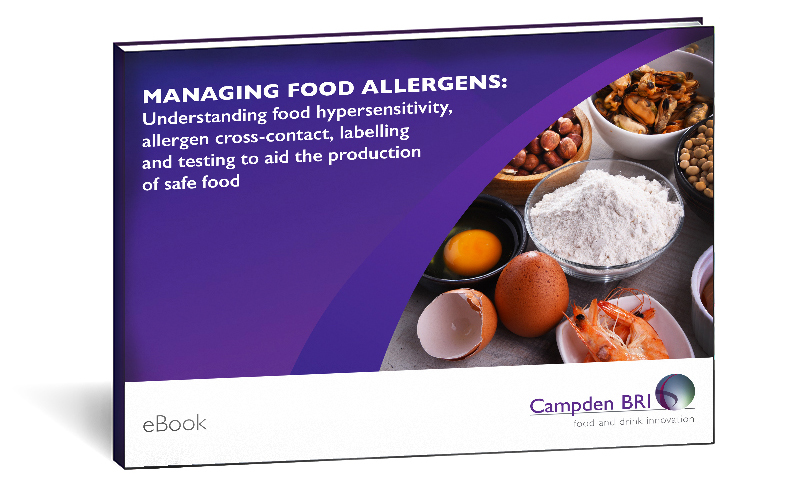
Food allergen labelling – the difference between ‘gluten’ and ‘cereals containing gluten’
4 August 2023 | Helen Arrowsmith, Regulatory Affairs Manager and Allergen Specialist, Christopher James, Safety and Quality Specialist, Allergens and Lewis Wallis, Regulatory Affairs Advisor
Annex II to the FIC (Regulation (EU) No 1169/2011, as amended, on the provision of food information to consumers, which has been retained into UK law post EU Exit) lists 14 substances or products causing allergies or intolerances that must be emphasised in the ingredients list on the label of prepacked food and drink.
Such labelling requirements apply when these substances have been deliberately added as an ingredient or processing aid, or are part of a compound ingredient. The current legislation does not specifically deal with the unintentional presence of food allergens due to cross-contact, but there continue to be developments in this area (see our blog on ‘Are you following developments in precautionary allergen labelling and information?’).
Download our FREE Managing Food Allergens eBook today! Secure food safety, control and confidence through effective allergen management

Whilst the existence and content of the legislation is broadly well-known, there still remain a number of common misconceptions and misinterpretations. One area we are frequently asked about for interpretation guidance is on the topic of ‘cereals containing gluten’ and ‘gluten’.
To explain the interpretation of the legislation in the EU and UK with regard to gluten, firstly, it is important to understand the health conditions that are referred to as food hypersensitivity and how different people can react.
Food hypersensitivity definitions
Food hypersensitivity refers to non-toxic, adverse reactions that take place when susceptible individuals consume, otherwise ingest, or come into contact with, certain foods. Food hypersensitivity can be broadly categorised into two groups — non-immune mediated food intolerances and immune-mediated reactions.
Non-immune mediated food intolerances include enzymatic intolerances, reactions to sulphites and pharmacological reactions (for more information, download our eBook).
Immune-mediated reactions on the other hand involve the immune system and are further classified into two groups, an understanding of which helps to explain the common misconception around ‘gluten’ and ‘cereals containing gluten’.
The different types of immune-mediated reactions are:
- Non-IgE mediated reactions – Such as coeliac disease, and associated conditions including dermatitis herpetiformis, as well as non-IgE-mediated food allergies (symptoms are typically delayed for >2 hours after ingestion). For people that have coeliac and other related diseases, gluten can cause an autoimmune reaction in which the ingestion of gluten triggers the body to attack its own tissues. Symptoms include damage to the intestinal lining, diarrhoea, fatigue, weight loss, bloating and anaemia. It is important to make the distinction that coeliac disease is not a ‘true’ IgE-mediated allergic reaction and should be viewed as a separate condition. and
- IgE-mediated reactions – Symptoms of an IgE-mediated allergic reaction can range from mild such as itching around the mouth and rashes, to more severe symptoms such as vomiting, diarrhoea, difficulty breathing and, on occasion, anaphylaxis (shock). Such symptoms usually occur within 2 hours of ingestion.
Gluten vs Cereals containing gluten
Gluten
Whilst gluten is one of the proteins to which those with ‘true’ IgE-mediated food allergy can react, gluten itself is not included in the FIC Annex II list of substances or products causing allergies or intolerances that must be labelled. The FIC does not therefore require the term ‘gluten’ to be emphasised.
It should be noted that gluten-free foods, and the limit of ≤ 20 mg/kg to make this claim, relate to food suitable for people with coeliac disease (refer to Commission Implementing Regulation (EU) No. 828/2014 for details). It is another common misconception that this level relating to making a ‘gluten-free’ claim also applies to the allergen declaration required by the FIC; this is not correct and FIC Annex II allergens must be emphasised in all cases when they are added to foods (unless of course they are exempt). The only substances in FIC Annex II with an associated level with regard to allergen declaration are sulphur dioxide and sulphites, concentrations of which above 10 mg SO2/kg or mg SO2/L in the final product trigger the allergen labelling requirement.
Cereals containing gluten
People with food allergy can suffer ‘true’ IgE-mediated allergic reactions to a range of proteins found in ‘cereals containing gluten’ (including gluten, but also albumins, globulins, α-amylase inhibitors and lipid transfer proteins for example - see EFSA Opinion (2014) for further information). ‘Cereals containing gluten’ or, more specifically, wheat (such as spelt and khorasan wheat), rye, barley, oats or their hybridised strains are included in the FIC Annex II list of substances or products causing allergies or intolerances. It is the cereals specifically to which the legislation refers, therefore it is the name of the cereals (stipulated as wheat, rye, barley, oats, their hybridised strains, and products thereof) that should be emphasised in the ingredients list of products that contain them. This is important as people can be allergic to one cereal containing gluten, but not another.
As stated above, there are no levels associated with the FIC requirement to label ‘cereals containing gluten’, therefore these must be declared and emphasised unless they are listed in FIC Annex II as exempt from this requirement.
The gluten-free claim is for foods suitable for those with coeliac disease and related conditions, whereas the allergen labelling requirements in Annex II to the FIC relate to food information for people with a true food allergy to 'cereals containing gluten’.
Misconception: Assuming that gluten-free products do not pose a risk to consumers with allergies to cereals containing gluten –
In the EU and UK a gluten-free product can contain a gluten-containing cereal ingredient, for example, an ingredient derived from barley. If the gluten content from this ingredient results in a level in the final product of less than or equal to 20 mg gluten/kg, then the product can be claimed to be gluten-free. But what about the risk from the other proteins from this cereal-derived ingredient? The answer is that people can be allergic to these and as such barley (in this example) would need to be declared and emphasised on the product label in line with allergen labelling requirements in the FIC to inform those with an allergy to barley that it is present.
The special case of gluten-free oats
Oats do not inherently contain gluten (although they do contain similar proteins, called avenins, that can trigger coeliac disease in a small proportion of people, as well as oat proteins that can cause food allergic reactions). The bigger issue with oats causing reactions is their cross-contact in the supply chain with other cereals that do contain gluten (e.g. wheat, rye, barley and their hybridised strains). Special requirements are laid down for gluten-free oats (see Commission Implementing Regulation (EU) No. 828/2014), in that they must have been specially produced, prepared and/or processed in a way to avoid contamination by wheat, rye, barley, or their crossbred varieties and the gluten content of such oats cannot exceed 20 mg/kg. It should be remembered however that oats themselves are required to be emphasised as allergens in accordance with the FIC, even if they are gluten-free. This is because that level of 20mg gluten/kg is for protection of those with coeliac disease, not those with food allergy.
We can help you to help your consumers through compliant food allergen labelling
If you would like a full label review from our global regulatory experts to check the compliance of your products across UK/EU and Global markets, get in touch with the Regulatory Affairs team (regulatoryadvice@campdenbri.co.uk).
Dealing with food allergens can be challenging – but our teams are here to help. We offer a range of services to support your food allergen management needs, including; testing, training, consultancy and support in food allergen management, labelling and legislation. These services can be customised to your requirements.
Alternatively, for more information on the topic areas above, and the many other necessary considerations when producing legally compliant products, check out our training courses.

About Christopher James
Christopher James is a Safety, Quality and Allergens Specialist who uses his knowledge and expertise to manage consultancy and research projects, tutor courses in all areas of food safety and quality management and provide specialist support to clients with substances causing food hypersensitivity (including food allergens). He joined the Global Safety and Quality team at Campden BRI in 2019, after roles in various public health and food organisations, bringing his knowledge of nutrition, health, dietary conditions (including food hypersensitivity), food safety, quality and science.
Christopher has authored peer-reviewed articles, book chapters, guidance and reports on current scientific and industry topics, including collaborating with BRCGS in the development of guidance on ‘Effective Allergen Management’. He graduated from Coventry University with a BSc (Hons) in Nutrition Studies, is a Registered Nutritionist (RNutr) and a Member of the Institute of Food Science and Technology (MIFST). Alongside his current role, he is undertaking a PhD at the University of Nottingham conducting research into current and emergent allergens in food production systems.
For more information, please contact:
Food allergen labelling and other legislation issues:
Preventing and monitoring allergen cross-contact:
Managing Food Allergens eBook
Download our FREE Managing Food Allergens eBook today! Secure food safety, control and confidence through effective allergen management.







